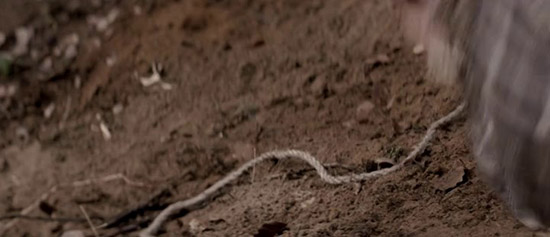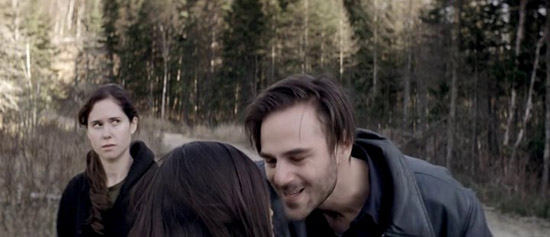SYNOPSIS:
A hunt for easy money turns into a deadly search for a missing loved one as outsiders confront the evil forces behind a native American myth.
REVIEW:
The past year or so in horror cinema has not been particularly kind to indigenous peoples…not that the previous century in horror has done them so many favors, either.
The recent cannibal opus The Green Inferno may well have been the stinking tip of the noxious iceberg, portraying a “lost” tribe of indigenous Amazonians as wild, murderous, flesh-eating savages. Apparently, not having access to modern conveniences like high-speed streaming services can turn an entire civilization of natives into cannibalistic killers, to which I suppose any of us who have ever experienced our own occasional internet outages can certainly attest.
But The Green Inferno is not exactly unique. When indigenous or native peoples aren’t being portrayed on film as cannibals, they are usually reduced to other convenient stereotypes. From the “noble Indian” to the “wise Shaman” to the “wicked Medicine Man” and beyond: characterizations of indigenous and native people tend to fit nicely into one of a very few two-dimensional, preconceived boxes. And that doesn’t even count the films that feature no native people at all but are driven by desecration of the mysterious and all-powerful “Indian burial grounds”.
Sadly, in that regard, Feed the Devil is essentially more of the same.
Directed by Max Perrier, Feed the Devil purports to be “inspired by the plastered skulls of ancient Jericho”, which unfortunately appears to actually have nothing at all to do with the plot or the so-called “evil forces behind a Native American myth” that drive the action of the film. Like much of Feed the Devil, the inspiration and the thematic foundation appear to be a bunch of random, paper-thin ideas taped loosely together in the hope that it will seem substantial. But it does not.
Marcus, Lydia, and Stella are down-on-their-luck grifters who get a tip that a treasure trove of weed—worth enough to get them back on their feet and to set their lives on track—is just sitting there waiting for them in some remote cabin in the mysterious wilds of the Alaskan backwoods. The score, which is supposedly payment on an old family debt, simply requires them to hop in the car and go pick it up.
If only it were so simple.
Once deep in the Alaskan wilderness, the trio gets lost and then separated, and it soon becomes clear that they are being hunted by some mysterious and possibly mystical—and certainly evil—force. Eventually, they come upon a reclusive Native woman, and when some of the group stumble upon some sparsely populated reservation land, it is soon revealed that they are tempting their fate by desecrating the sacred hunting grounds of some mythic Native gods.
Or something. It’s never quite clear what the hostile force is or why it’s so hostile, but Feed the Devil shows and tells you just enough to make it clear that it’s Native-ish and it’s evil-ish, and the filmmakers clearly believe that those two together should be enough for a horror movie like this.
Jared Cohn anchors Feed the Devil as Marcus, who ultimately becomes the film’s primary focus as the other characters fall away. Cohn, who has dozens and dozens of credits as a film actor, writer, and director—mostly of the low-budget and exploitative fare—does a decent job oozing indifference and irreverence, and his ability to convey Marcus’ gradual, sinking realization that his big score might just be a fool’s errand lends some much-need stakes to the otherwise meandering storyline.
The real star of Feed the Devil, though, is the beautiful and foreboding Alaskan wilderness, which is photographed excellently by cinematographer Ludek Kameny. Kameny—who lists Feed the Devil as his first film credit—and his camera lend the atmospheric film nearly its entire sense of mystery, suspense, and dread, and even more so than the ominous phantoms that haunt the forest, the forest itself emerges as the most malevolent of villains.
The thing about Feed the Devil that is so frustrating, though, is that at several points in the film it appears to be an easy-to-dismiss, low-quality mess of sanctimonious garbage. But then—then!—there are moments when it really starts to get under your skin, when the unlikeable protagonist becomes engaging and almost heroic, and when the whole thing—despite its apparently modest budget and its embarrassing approach to cultural appropriation—starts to feel sort of epic.
There even comes a time when Marcus’ mission becomes less about greed and more about love (or at least the rough equivalent of love that a character so shallow and compromised can experience), and Feed the Devil starts to take on the moral imperative and stature of a quest. But then, just like that, the moment is gone and the film stumbles—a cheap special effect here, an embarrassingly simple-minded stereotype there, or a ludicrous decision by a character—and once again Feed the Devil deflates and resumes the shape and size of your average, forgettable, low-budget indie horror fare.
 Horror News | HNN Official Site | Horror Movies,Trailers, Reviews
Horror News | HNN Official Site | Horror Movies,Trailers, Reviews

















